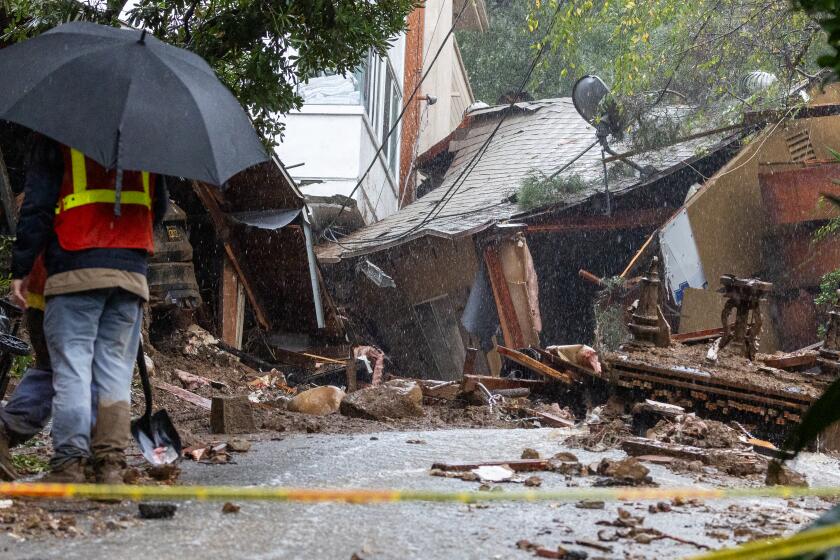Your house has water damage from the storm. Now what?

- Share via
For thousands across the Southland, this week’s storms brought unwanted water into their houses, condos and businesses due to flooding, leaky roofs or other causes.
The task now for many property owners is to dry out their interior spaces and prevent further damage due to mold and mildew. Not just an unsightly and smelly nuisance, mold is a potential health hazard that can require costly additional repairs if it’s not addressed properly and relatively quickly. Once it does appear, it’s imperative that you take steps to address it before it spreads.
To get some answers about what to do when you’ve got moisture in the walls, floors, ceilings or insulation of your home or business, The Times spoke to mold remediation professionals and other experts.
Here’s what they said:
1. Don’t make it worse
The first thing you should do is make sure you don’t exacerbate the problem. If money’s tight, it may be tempting to try to fix the problem yourself.
If you’re lucky and mold hasn’t started to grow, it may be O.K. to run some fans or pull up a damp patch of carpet. But if areas of moisture remain, mold will likely follow within a few days.
Once you start to see visible mold or smell its telltale dank odor, it may already be too late to take purely preventive measures. Even just running fans could spread mold spores throughout your home, as could removing moldy materials.
2. Call a professional
As soon as you can after an event like a storm or a pipe break causes water to pour into your home or business, you should get in touch with someone who knows what they’re doing.
One good option is to contact a full-service water damage recovery and mold remediation company. These firms are inundated with calls after inclement weather, so the sooner you call them the better. They’ll start out by talking you through what you’re facing and will typically send someone to assess the damage and how to address it.
This week’s megastorm has damaged many rentals as it barrels through the state. Here is what renters can do to fix the damage.
You’ll also need to consider whether — and when — to get in touch with your insurance company. This is a personal decision, but there are some important questions to consider before you make that call. For instance, what’s your deductible and how much do you expect the bill to repair the damage to be? Do you have flood insurance and what exactly does your policy cover? If you anticipate costly repairs, it might even be worth consulting with a property damage attorney to help you navigate the claims process.
Joel Moss, chief business development officer for Paul Davis Restoration in Santa Clarita, said he recommends a property owner’s first call be to a company that can come to your home and determine what’s needed.
“We can come out and assess what’s going on and give them some professional feedback,” he said, “rather than calling their insurance company first and then finding out that it may not be a covered claim, or if the damage is so small that it’s not going to be beneficial to run the deductible.”
3. Water mitigation
If it’s soon enough after the storm and the water hasn’t permeated too deeply, you might be looking at a minimally invasive mitigation process, according to Shay Benhamo, office manager at Green Planet Restoration in Chatsworth.
By removing moisture before mold can take hold, you can avoid the high costs and lengthy processes often associated with mold remediation. Sometimes just mitigating water can cost a few thousand dollars. But it’s always less expensive and disruptive than waiting until there’s mold.
“Sometimes you can just dry it out with machines,” Benhamo said, “and sometimes you have to actually remove wet material, like two feet of wet drywall.”
4. Mold remediation
There are hundreds of varieties of mold that can show up in indoor spaces, and their appearance can vary widely. Mold can be blue, green, white — essentially any color. If it’s black, you should be particularly concerned, but the feared black mold is not the only variety that can cause respiratory problems and other health issues.
Probably not. That’s because in Los Angeles County, home to nearly 10 million people, there are just 14,580 flood insurance policies on the books.
Just because you can’t see it doesn’t mean there isn’t mold. If you know you’ve had significant moisture inside your home or business for three or more days, or if you smell it in the air, you’ll likely need to pursue mold remediation.
All water and moisture will first need to be mitigated, and any moldy materials will need to be removed. That can mean losing parts of your floor, walls and even furniture and other belongings.
Paul Davis Restoration’s standards require that when mold is found in a floor, ceiling or wall, the moldy portion must be cut out and removed, Moss said, along with two extra feet in every direction past the part where mold can be seen.
After the materials are removed, the next step is rebuilding the affected portions of your home or business. Full-service water recovery and mold remediation providers can handle that work, or a capable contractor can be brought in to handle the reconstruction process.
5. Prevention
You’ve spent thousands of dollars on water mitigation, mold remediation and reconstruction. But what’s stopping water from entering your home or business again next time there’s heavy rains or flooding?
It’s essential that you find an engineer who can work with you to ensure proper drainage if flooding or blocked outdoor drains were the issue. If a roof leak or other structural problem was the cause of your property’s water damage, you’ll need to work with a contractor who can reinforce your roof or other parts of your home or business to ensure they’re able to keep water at bay next time there’s a torrential rain and flooding event.
Because if there’s anything Southern Californians have learned these last couple of years, it’s that there will be a next time.
The city was still working its way through 562 mudslides as of Wednesday evening. Burn scars, loose earth and improper construction are all factors.
More to Read
Sign up for Essential California
The most important California stories and recommendations in your inbox every morning.
You may occasionally receive promotional content from the Los Angeles Times.












